Need help?
Unsure whether you need a bath or a plunge, portable or fixed, chiller or iced? Check out Sasha’s cold plunge vs ice bath article to answer all and get clarity on your cold immersion needs.
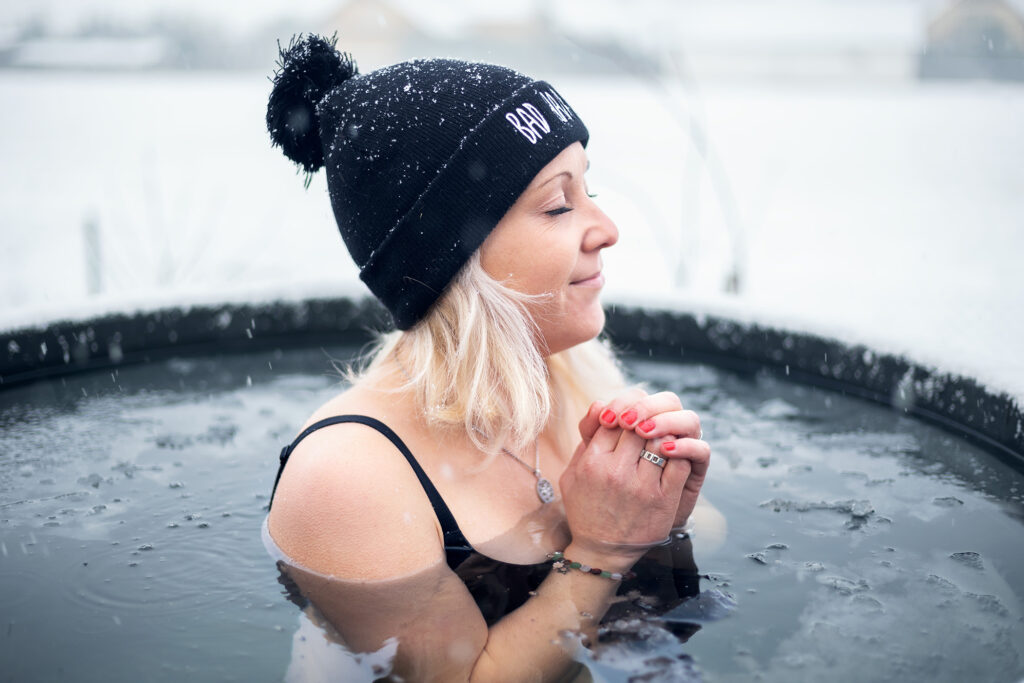
I used to think cold showers were just for masochists and polar bears. The idea of voluntarily subjecting myself to icy water seemed about as appealing as a root canal without anesthesia.
But then, on a dare from a friend, I took my first cold plunge.
The initial shock was intense, like thousands of tiny needles pricking my skin. But as I focused on my breath and pushed through the discomfort, something remarkable happened. A wave of exhilaration washed over me, leaving me feeling more alive and alert than I had in years.
That first cold plunge was the beginning of an exciting experience. From boosting mood and energy levels to reducing inflammation and improving recovery times, cold plunging seemed like a secret cure hiding in plain sight.
But like any powerful tool, cold plunging comes with it’s own set of challenges and potential risks. It’s crucial to understand the proper techniques and safety precautions before diving in headfirst.
There’s an art and science to cold exposure that, when understood and applied correctly, can unlock a whole new level of physical and mental performance.
Whether you’re a seasoned ice bather or a curious newcomer, prepare to explore the transformative power of embracing the chill.
Contents
- 1 Science of the Cold Plunge: Understanding the Body’s Response
- 2 Methods of Cold Plunging: From Shower to Cryochamber
- 3 Implementing Your Cold Plunge Routine: A Step-by-Step Guide
- 4 Common Pitfalls and How to Avoid Them
- 5 Adapting Cold Plunging to Different Scenarios
- 6 From Novice to Cold Plunge Pro: Building on the Basics
- 7 Exercises to Enhance Your Cold Plunge Practice
- 8 Frequently Asked Questions
- 8.1 What are the benefits of cold plunging?
- 8.2 How long should a cold plunge last?
- 8.3 What temperature should the water be for a cold plunge?
- 8.4 Is cold plunging safe for everyone?
- 8.5 Can cold plunging help with fat loss?
- 8.6 How often should I do cold plunges?
- 8.7 Can cold plunging improve mental health?
- 8.8 Is it normal to feel shaky after a cold plunge?
- 8.9 Can I cold plunge if I’m pregnant?
- 8.10 How do I build up my cold tolerance?
- 9 Key Takeaways
Science of the Cold Plunge: Understanding the Body’s Response
Cold plunging triggers several fascinating physiological changes in the body:
Vasoconstriction and the Mammalian Dive Reflex
The moment you hit the cold water, your blood vessels constrict, redirecting blood flow from your extremities to your vital organs. This is part of the mammalian dive reflex, an evolutionary adaptation that helps us survive in cold water.
The redirection of blood flow helps conserve heat and protect your core organs. This reflex is particularly strong when cold water hits your face, which is why even a brief face dunk in cold water can be invigorating.
The Norepinephrine Surge
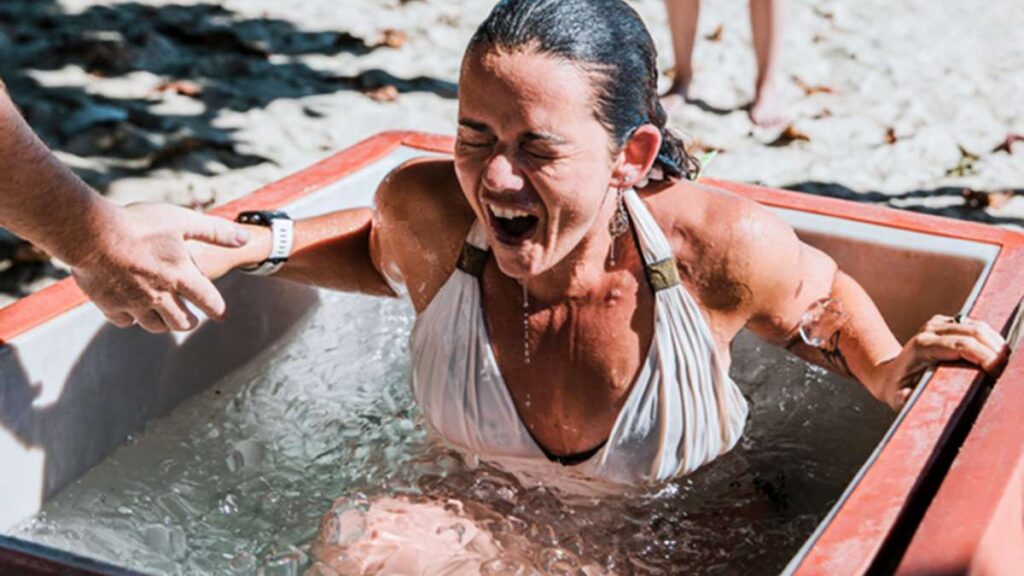
Cold exposure triggers a significant increase in norepinephrine, a hormone and neurotransmitter that can boost mood, focus, and attention. Studies have shown that cold water immersion can increase norepinephrine levels by up to 530%.
This surge is responsible for the mental clarity and mood boost many people experience after a cold plunge. It’s like a natural, drug-free way to kickstart your brain and elevate your mood.
Brown Fat Activation: Your Body’s Built-in Furnace
Cold temperatures activate brown adipose tissue (BAT), also known as brown fat. Unlike white fat, which stores energy, brown fat burns calories to generate heat.
Regular cold exposure can increase the amount and activity of brown fat in your body, potentially aiding in weight management and metabolic health. This means that shivering in cold water might actually help you burn more calories throughout the day.
Inflammation Reduction: A Natural Anti-Inflammatory
Cold exposure can decrease the production of pro-inflammatory cytokines while increasing anti-inflammatory cytokines. This shift in the inflammatory response can help reduce systemic inflammation, which is linked to numerous chronic diseases.
For athletes or anyone dealing with muscle soreness, this anti-inflammatory effect can be particularly beneficial for recovery and pain reduction.
Vagus Nerve Stimulation: The Cold Water Connection
The shock of cold water on your face can stimulate the vagus nerve, a key component of the parasympathetic nervous system. This stimulation can lead to improved mood, reduced anxiety, and better overall nervous system function.
The vagus nerve plays a crucial role in our “rest and digest” response, so stimulating it through cold exposure can help counteract the effects of chronic stress and promote relaxation.
Cold Shock Proteins: Cellular Protectors
Exposure to cold triggers the production of cold shock proteins, which may have protective effects on the body. These proteins can help preserve muscle mass, improve insulin sensitivity, and even enhance longevity in some animal studies.
While more research is needed in humans, the potential cellular benefits of cold exposure are intriguing and may contribute to overall health and resilience.
Methods of Cold Plunging: From Shower to Cryochamber
There’s more than one way to take the plunge. Here are some popular methods, ranging from the easily accessible to the more specialized:
The Cold Shower: Your Daily Dose of Chill
Starting with cold showers is an excellent way to build cold tolerance and reap some of the benefits of cold exposure without any special equipment. Here’s how to get started:
- Begin with 30 seconds of cold water at the end of your regular shower.
- Gradually increase the duration of cold exposure over time.
- Focus on controlled breathing to manage the initial shock.
- Try to work up to 2-3 minutes of cold water exposure.
Cold showers are accessible to almost everyone and can be a great way to build cold tolerance. They’re also perfect for those days when you don’t have time for a full cold plunge session.
Ice Baths: The Classic Cold Plunge
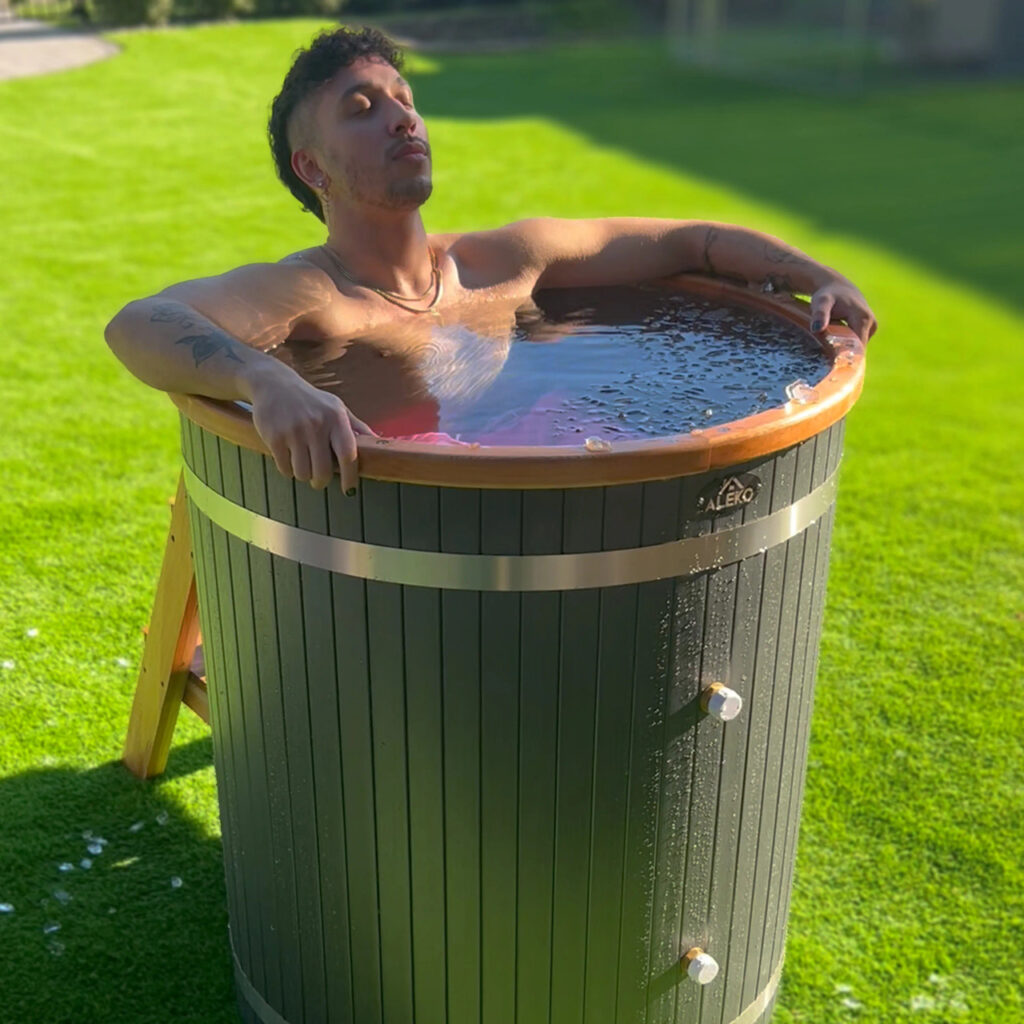
An Ice bath offers a more intense cold exposure experience and allows for full-body immersion. Here’s how to set up and use an ice bath:
- Fill a bathtub with cold water and ice, aiming for a temperature between 50-59°F (10-15°C).
- Use a thermometer to monitor the water temperature.
- Start with short immersions of 1-2 minutes and gradually increase duration as you build tolerance.
- Always have a spotter present for safety.
Most people move on to a dedicated ice bath fairly quickly, for ease of use and better insulation. Marcus’s list of top portable ice baths will lead you through the best-on-a-budget while my list of best ice bath tubs shows the options for those that have become dedicated plungers.
Ice baths allow for longer exposure times and full-body immersion, which can enhance the physiological benefits of cold exposure. They’re popular among athletes for post-workout recovery but can be beneficial for anyone looking to explore cold therapy.
Natural Bodies of Water: Nature’s Cold Plunge
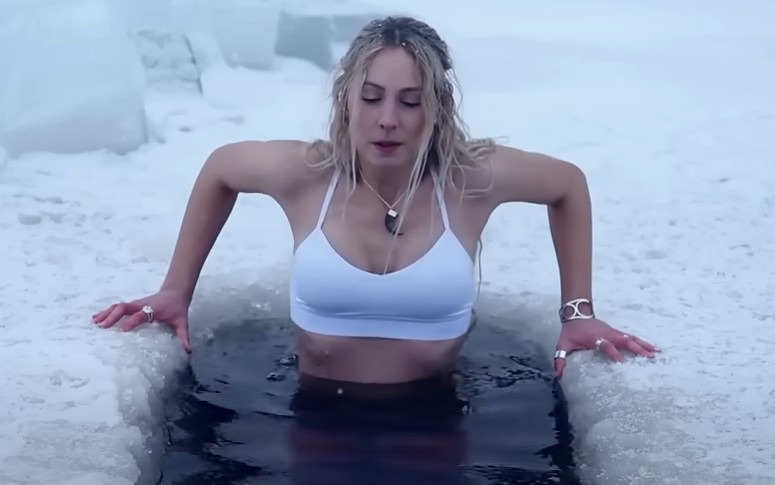
Lakes, rivers, and oceans can provide a natural cold plunge experience. The added benefit of being in nature can enhance the mental health benefits of cold exposure.
Here are some tips for natural cold plunging:
- Always check water conditions and temperature before entering.
- Never swim alone in natural bodies of water.
- Be aware of currents, tides, and potential hazards.
- Start with brief exposures and stay close to shore.
Natural cold plunging can be an exhilarating experience, combining the benefits of cold exposure with the rejuvenating effects of nature. However, it’s crucial to prioritize safety and be aware of your surroundings.
Cold Plunge Tubs: The Home Ice Bath
Specialized tubs and baths designed for cold water immersion often come with temperature control features. While more expensive, they offer convenience and precision for regular practitioners.
Benefits of cold plunge tubs include:
- Precise temperature control
- Easy maintenance and cleaning
- Convenient for daily use
- Some models offer additional features like filtration systems
If you’re serious about incorporating cold plunging into your daily routine, a dedicated cold plunge tub can be a worthwhile investment.
>>Let Johnny guide you through his best cold plunge tub review so you don’t take a wrong turn.<<
Cryotherapy Chambers: The High-Tech Option
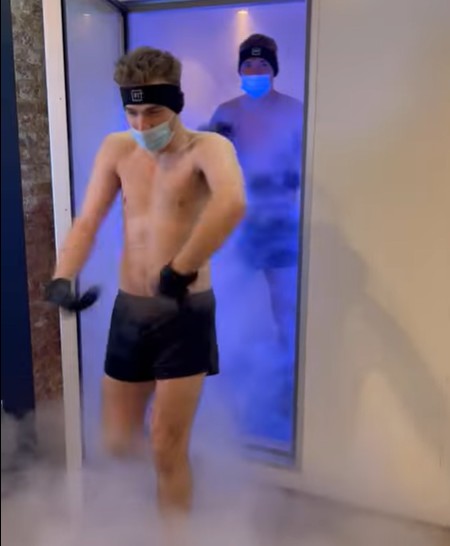
Whole-body cryotherapy exposes the body to extremely cold air for short periods. While not technically a ‘plunge,’ it offers intense cold exposure and is popular among athletes and biohackers.
Here’s what you need to know:
- Sessions typically last 2-3 minutes.
- Temperatures can range from -166°F to -220°F (-110°C to -140°C).
- Protective gear is worn to prevent frostbite.
- Always use cryotherapy chambers under professional supervision.
Cryotherapy offers a different kind of cold exposure experience, with potential benefits for recovery, pain management, and overall well-being. However, it’s important to use these chambers responsibly and under proper guidance.
Implementing Your Cold Plunge Routine: A Step-by-Step Guide
Creating a consistent cold plunge routine is key to reaping the full benefits of cold exposure. Here’s a comprehensive guide to help you get started:
1. Start Gradually
Beginning your cold plunge practice requires patience and a willingness to start small. Here’s how to ease into it:
- Begin with brief exposures of 30 seconds to 1 minute.
- Focus on controlled breathing to manage the initial shock.
- Slowly increase duration as your body adapts, adding 5-10 seconds each session.
- Pay attention to how your body responds and adjust accordingly.
Remember, cold plunging is a skill that improves with practice. Don’t be discouraged if it feels challenging at first – that’s completely normal.
2. Set a Consistent Schedule
Consistency is crucial for building cold tolerance and reaping long-term benefits. Here’s how to make cold plunging a regular part of your routine:
- Aim for regular cold exposure, such as daily cold showers or weekly ice baths.
- Choose a time of day that works best for you and stick to it.
- Start with 2-3 sessions per week and gradually increase frequency.
- Use a calendar or app to track your cold plunge sessions and progress.
By making cold plunging a consistent habit, you’ll find it becomes easier over time, and the benefits will become more pronounced.
3. Focus on Breathing
Proper breathing techniques are essential for managing the cold shock response and staying calm during your plunge. Try this box breathing technique:
- Inhale deeply through your nose for 4 counts.
- Hold your breath for 4 counts.
- Exhale slowly through your mouth for 4 counts.
- Hold your breath for 4 counts.
- Repeat this cycle throughout your cold exposure.
Practice this breathing technique before entering the cold water, and continue focusing on your breath throughout the plunge. This will help you stay relaxed and in control.
4. Warm Up First
Light exercise before your plunge can make the initial shock less intense and help you stay in longer. Here’s a quick pre-plunge warm-up routine:
- Do 1-2 minutes of jumping jacks or jogging in place.
- Perform 10-15 bodyweight squats.
- Do 10-15 arm circles in each direction.
- Finish with 30 seconds of high knees.
This warm-up will increase your heart rate and body temperature, making the transition into cold water less jarring.
5. Enter Slowly
Gradual immersion can help manage the cold shock response. Here’s how to enter the cold water:
- Start by submerging your feet and lower legs.
- Slowly walk deeper into the water, allowing each part of your body to adjust.
- Take deep, controlled breaths as you continue to immerse yourself.
- Once chest-deep, consider dunking your head under water if you feel comfortable.
This gradual approach allows your body to adapt to the cold more effectively than jumping in all at once.
6. Stay Safe
Safety should always be your top priority when cold plunging. Follow these guidelines:
- Never plunge alone, especially when starting out.
- Be aware of the risks of hypothermia and cold shock.
- Keep your cold exposure sessions short (1-3 minutes) when beginning.
- Have warm, dry clothes ready for when you exit the water.
- If you have any pre-existing health conditions, ask with a doctor before starting a cold plunge practice.
7. Listen to Your Body
Paying attention to your body’s signals is crucial for a safe and effective cold plunge practice:
- If you experience persistent discomfort or adverse reactions, exit the cold water and warm up gradually.
- Watch for signs of hypothermia, such as intense shivering, confusion, or slurred speech.
- Be mindful of how you feel after each session and adjust your practice accordingly.
- Celebrate small victories and improvements in your cold tolerance.
Remember, cold plunging is a personal practice, and what works for one person may not work for another. Trust your instincts and adjust your approach as needed.
Common Pitfalls and How to Avoid Them
As you start on your cold plunging journey, be aware of these common mistakes and learn how to sidestep them:
1. Overdoing It
Excessive cold exposure can lead to hypothermia or cold stress. More isn’t always better when it comes to cold plunging.
Here’s how to avoid overdoing it:
- Stick to recommended durations and temperatures, especially when starting out.
- Gradually increase your exposure time over weeks or months, not days.
- Listen to your body and exit the water if you feel excessively uncomfortable or numb.
- Remember that consistency is more important than intensity.
2. Ignoring Warning Signs
Paying attention to your body’s signals is crucial for safety. Be aware of these warning signs:
- Numbness in extremities
- Severe shivering that doesn’t subside
- Blue lips or skin
- Confusion or disorientation
If you experience any of these symptoms, exit the cold water immediately and warm up gradually. Seek medical attention if symptoms persist.
3. Neglecting Proper Warm-Up
Failing to warm up beforehand can make the experience unnecessarily uncomfortable and potentially dangerous. Here’s why warming up matters:
- It increases your core body temperature, making the initial shock less intense.
- It improves blood circulation, helping your body manage the cold more effectively.
- It prepares your mind for the challenge ahead.
Always take a few minutes to engage in light exercise before your cold plunge.
4. Inconsistency
Sporadic cold exposure won’t yield the same benefits as a regular practice. Consistency is key for building cold tolerance and reaping long-term benefits.
To stay consistent:
- Set a regular schedule for your cold plunges.
- Start with a frequency that’s manageable for you, even if it’s just once or twice a week.
- Use reminders or alarms to help you stick to your schedule.
- Track your progress to stay motivated.
5. Holding Your Breath
The shock of cold water might make you want to hold your breath, but this can increase stress on your body. Instead:
- Focus on steady, controlled breathing.
- Practice breathing exercises before entering the water.
- If you feel panicked, focus on exhaling fully to trigger a natural inhale.
Proper breathing will help you stay calm and maximize the benefits of your cold plunge.
Adapting Cold Plunging to Different Scenarios
Cold plunging can be tailored to various goals and lifestyles. Here’s how to adapt your practice for different scenarios:
For Athletes: Post-Workout Recovery
Cold plunges can be a powerful tool for athletes looking to enhance recovery and reduce muscle soreness. Here’s how to incorporate cold plunging into your athletic routine:
- Use cold plunges after intense workouts to aid recovery and reduce inflammation.
- Aim for 10-15 minutes of cold exposure within 30 minutes of finishing your workout.
- Alternate between cold plunges and active recovery techniques for optimal results.
- Consider contrast therapy (alternating hot and cold) for enhanced circulatory benefits.
For Stress Relief: Morning Mood Boost
Incorporating cold exposure into your morning routine can set a positive tone for the day:
- Start with a brief cold shower (30 seconds to 2 minutes) as part of your morning routine.
- Focus on deep, controlled breathing to manage the initial shock.
- Follow your cold exposure with a few minutes of meditation or mindfulness practice.
- Notice how your mood and energy levels change throughout the day.
For Sleep Improvement: Evening Cool Down
Cold exposure a few hours before bedtime can help regulate your body temperature for better sleep:
- Take a cool (not ice-cold) shower about 2-3 hours before bed.
- Gradually decrease the water temperature over 2-3 minutes.
- End with 30 seconds to 1 minute of the coldest water you can tolerate.
- Follow with relaxing activities to prepare for sleep.
For Mental Clarity: Midday Reset
Use cold plunges as a tool to break through mental fog or creative blocks:
- Take a brief cold shower or face plunge during your lunch break.
- Focus on the sensation of the cold water to practice mindfulness.
- Follow with a few minutes of deep breathing or light stretching.
- Notice how your mental clarity and focus improve afterward.
For Immune Support: Seasonal Boost
Regular cold exposure can help boost your immune system, especially during cold and flu season:
- Incorporate brief cold showers (30 seconds to 1 minute) into your daily routine.
- Gradually increase the duration and decrease the temperature over time.
- Combine with other immune-boosting practices like proper nutrition and adequate sleep.
- Be consistent with your practice, especially during high-risk seasons.
From Novice to Cold Plunge Pro: Building on the Basics
As you progress in your cold plunging journey, you’ll find that your body adapts and becomes more resilient to cold exposure. This adaptation opens up new possibilities for pushing your limits and exploring advanced techniques:
Longer Durations
Gradually increase your time in cold water, working up to 10-15 minutes for experienced practitioners. Here’s how to safely extend your cold exposure:
- Increase your time in small increments (30 seconds to 1 minute) each week.
- Pay close attention to how your body responds to longer exposures.
- Always have a spotter present for extended cold plunges.
- Consider using neoprene gloves and booties to protect extremities during longer sessions.
Remember, longer isn’t always better. The key is finding the duration that provides most benefits without unnecessary risk.
Colder Temperatures
Slowly decrease the water temperature as your cold tolerance improves. Here’s how to approach colder plunges:
- Start by reducing the temperature by 1-2 degrees Fahrenheit each week.
- Use a reliable thermometer to accurately measure water temperature.
- Never go below 39°F (4°C) without professional supervision.
- Be extra vigilant about safety and have warm-up protocols in place.
Colder temperatures can enhance the physiological response to cold exposure, but they also increase the risk. Always prioritize safety over intensity.
Contrast Therapy
Alternate between hot and cold exposure for enhanced circulatory benefits. Here’s a basic contrast therapy protocol:
- Start with 3-5 minutes in hot water (100-104°F / 38-40°C).
- Immediately switch to 1-2 minutes in cold water (50-59°F / 10-15°C).
- Repeat this cycle 3-5 times, always ending with cold.
- Gradually increase the duration of cold exposure and decrease hot exposure over time.
Contrast therapy can be particularly beneficial for recovery and circulation, but it’s important to transition slowly between temperatures to avoid shock.
Breath Work Integration
Combine advanced breathing techniques like the Wim Hof Method with your cold plunges. Here’s a basic introduction:
- Before your plunge, perform 30-40 deep, rhythmic breaths.
- On the last breath, exhale fully and hold your breath for as long as comfortable.
- Take a deep breath in and hold for 15 seconds.
- Release and enter the cold water, focusing on calm, controlled breathing.
Advanced breathing techniques can enhance your ability to withstand cold and may amplify the physiological benefits of cold exposure.
Cold Exposure in Nature
Progress to wild swimming or ice hole diving for a more immersive experience. Here are some tips for safe cold exposure in nature:
- Always check water conditions and temperature before entering.
- Never swim alone in natural bodies of water.
- Wear suitable gear like neoprene gloves, boots, and a swim cap.
- Start with brief exposures and stay close to shore or exit points.
- Be aware of currents, tides, and potential hazards.
Cold exposure in nature can be an exhilarating experience, combining the benefits of cold therapy with the rejuvenating effects of the outdoors. However, it requires extra caution and preparation.
Exercises to Enhance Your Cold Plunge Practice
Incorporating these exercises into your routine can help you build cold tolerance and maximize the benefits of your cold plunge practice:
Cold Hands Challenge
Start by immersing just your hands in ice water for 1-2 minutes daily. This exercise helps build localized cold tolerance and can be done easily at home:
- Fill a bowl with ice water.
- Submerge your hands up to the wrists.
- Focus on slow, deep breathing.
- Start with 30 seconds and gradually increase to 2 minutes.
This exercise is great for beginners or as a quick cold exposure when you don’t have time for a full plunge.
Face Dunking
Submerge your face in cold water for 15-30 seconds to stimulate the dive reflex. This exercise can provide a quick boost of energy and focus:
- Fill a basin with cold water (add ice for extra chill).
- Take a deep breath and hold it.
- Submerge your face in the water for 15-30 seconds.
- Slowly lift your face out of the water and exhale.
- Repeat 3-5 times.
Face dunking is a great way to quickly activate the parasympathetic nervous system and can be particularly helpful for stress relief or mental clarity.
Cold Shower Progression
Gradually increase the duration of cold water at the end of your shower by 10 seconds each day. This consistent progression helps build overall cold tolerance:
- Start with 30 seconds of cold water at the end of your regular shower.
- Each day, add 10 seconds to your cold exposure.
- Aim to work up to 3-5 minutes of cold water.
- Focus on controlled breathing throughout the exposure.
This gradual approach helps your body adapt to cold exposure over time, making longer and colder plunges more manageable.
Mindfulness in the Cold
Practice meditation or mindfulness exercises during your cold exposure to enhance mental resilience:
- Enter your cold plunge or shower.
- Close your eyes and focus on your breath.
- Notice the sensations in your body without judgment.
- If your mind wanders, gently bring your attention back to your breath or the sensation of cold.
- Start with 1-2 minutes and gradually increase duration.
Combining mindfulness with cold exposure can amplify the mental benefits and help you stay present during challenging sensations.
Cold Exposure Journaling
Keep a log of your cold plunges, noting duration, temperature, and how you feel before and after. This practice can help you track progress and identify patterns:
- Before your plunge, note your mood, energy level, and any physical sensations.
- Record the water temperature and duration of your plunge.
- After your plunge, describe how you feel physically and mentally.
- Note any changes in mood, energy, or focus throughout the day.
Journaling can provide valuable insights into how cold exposure affects you personally and can help you optimize your practice over time.
Frequently Asked Questions
What are the benefits of cold plunging?
Cold plunging can boost mood, reduce inflammation, improve circulation, enhance recovery after exercise, and potentially support weight loss and immune function.
How long should a cold plunge last?
For beginners, start with 30 seconds to 1 minute. Experienced practitioners may work up to 10-15 minutes, but always listen to your body and exit if you feel uncomfortable.
What temperature should the water be for a cold plunge?
Ideal temperatures range from 50-59°F (10-15°C). Never go below 39°F (4°C) without professional supervision.
Is cold plunging safe for everyone?
While generally safe for healthy people, those with heart conditions, high blood pressure, or other health concerns should ask a doctor before starting a cold plunge practice.
Can cold plunging help with fat loss?
Cold exposure can activate brown fat and increase metabolism, potentially aiding in weight management when combined with a healthy diet and exercise.
How often should I do cold plunges?
Start with 2-3 times per week and gradually increase frequency as your body adapts. Some people practice daily, while others find 3-4 times per week enough.
Can cold plunging improve mental health?
Many people report improved mood, reduced anxiety, and increased mental clarity from regular cold exposure. The practice can also build mental resilience.
Is it normal to feel shaky after a cold plunge?
Mild shaking or shivering is normal as your body warms up. However, intense or prolonged shaking may indicate you’ve stayed in too long.
Can I cold plunge if I’m pregnant?
Pregnant women should ask with their healthcare provider before engaging in cold plunging, as extreme temperature changes may pose risks.
How do I build up my cold tolerance?
Start with brief exposures and gradually increase duration and decrease temperature over time. Consistency is key to building cold tolerance.
Key Takeaways
- Cold plunging triggers numerous physiological responses that can benefit physical and mental health.
- Start gradually and build consistency to reap the full benefits of cold exposure.
- Safety is paramount – always listen to your body and be aware of the risks associated with cold plunging.
- Proper breathing techniques are crucial for managing the cold shock response and maximizing benefits.
- Cold plunging can be adapted to various goals, from athletic performance to stress relief and improved sleep.
This website may contain affiliate links. As an affiliate, we may earn a commission from qualifying purchases at no additional cost to you.
